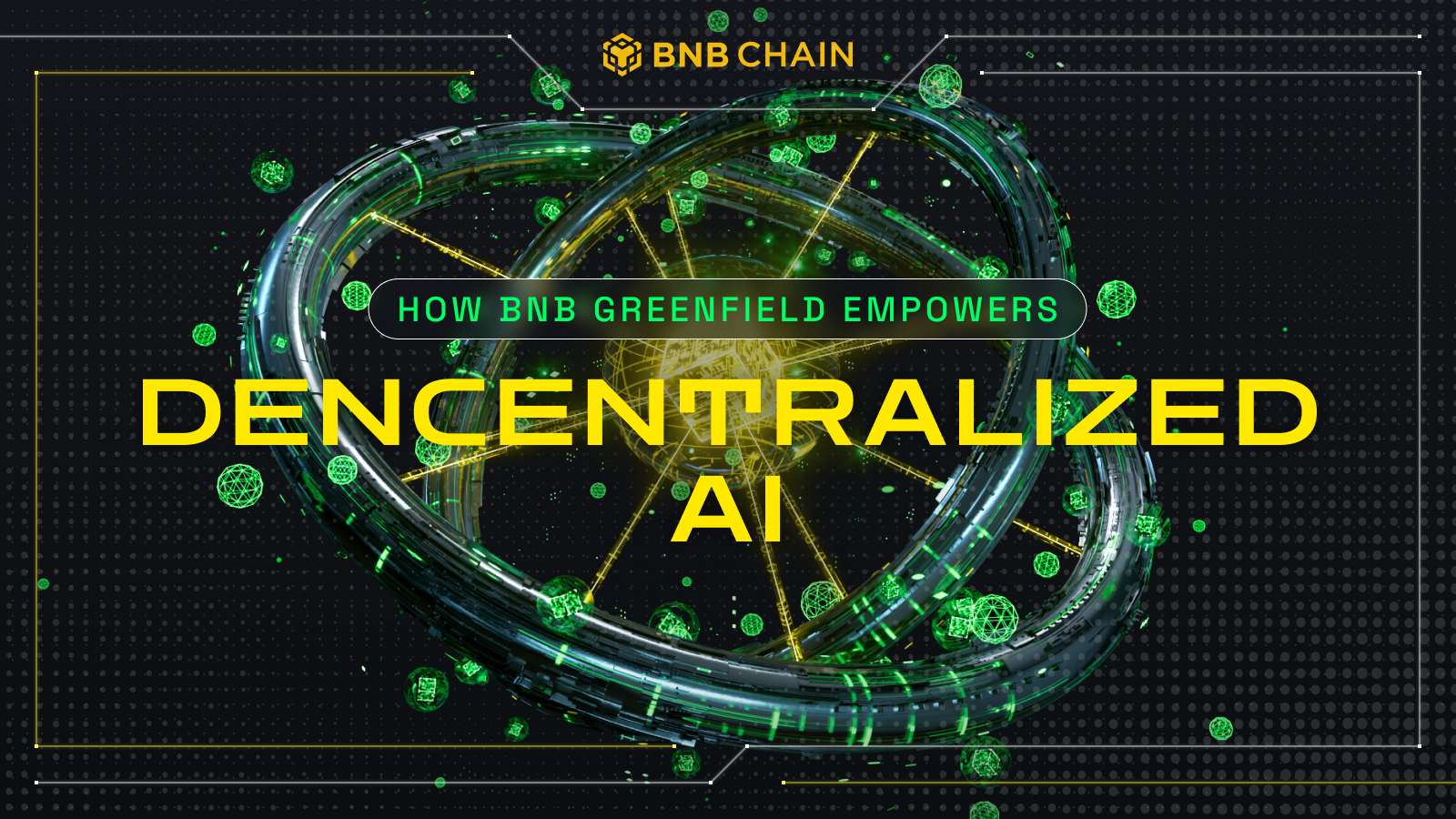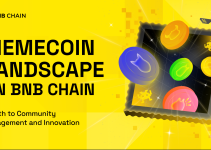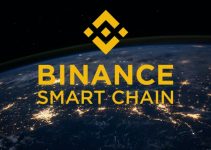Table of Contents

BNB Greenfield is one of the core pillars of the BNB Chain ecosystem. Its philosophy of treating “data-as-an-asset” is a groundbreaking approach that empowers users, giving them control over their personal information and empowering them to realize its value.
Greenfield’s programmable and cost-effective storage solution makes it the ideal foundation for decentralized AI applications. In this article, we will examine how projects like NFPrompt, Glows.ai, and Qna3 utilize Greenfield in their operations.
NFPrompt – Decentralized AIGC
NFPrompt merges Web3 with AI generated content (AIGC), empowering users to design and trade unique non-fungible tokens while engaging socially. It employs diverse AI models to produce non-fungible prompts (NFPs) and monetize them using Web3 technology.
These NFTs and their original prompts are traded on NFPrompt’s user-friendly marketplace, with processes like pricing, listing, and delisting being streamlined for ease of use. What sets these NFTs apart is that no two similar prompts will yield the same piece of art, and the records of these transactions are immutable on the blockchain, ensuring they cannot be altered.
The platform targets a wide user base, bridging Web2 and Web3 communities, and has already attracted 54,000 creators who have produced over 330,000 works.
How does NFPrompt use Greenfield?
NFPrompt’s current and future plans heavily rely on Greenfield. Even before Greenfield was live on mainnet, the platform had already integrated with Greenfield’s testnet.
The integration allows NFPrompt to manage its user-generated content more flexibly and offer users true ownership of their creations. The similarity of Greenfield’s experience to traditional Web2 storage services makes it easier for developers and users to adopt.
NFPrompt uses Greenfield for storing popular NFT artworks and benefits from its asset expansion feature, which is crucial for NFT commercialization. The integration will also help NFPrompt gain more flexibility on what it can do with user data to better synergize their products with user requirements.
Greenfield’s blockchain infrastructure also aids in tracking, licensing, and remixing AI-generated content. The future roadmap includes expanding the types of AI-generated content supported, such as video, music, and 3D assets. As the platform grows, the demand for decentralized storage is expected to increase significantly.
In future releases:
- NFPrompt will use Greenfield’s built-in access control to enhance user ownership, autonomy and privacy.
- Their engineering team may potentially integrate their inscription market with Greenfield in the future.
Glows.ai – Optimized AI Training
Glows.ai is a comprehensive platform designed to seamlessly connect and bridge the worlds of Artificial Intelligence (AI) and blockchain. It offers a full-suite environment that simplifies the process of building, developing, and scaling AI projects.
The platform specializes in AI-related dataset sharing and management, enabling users to access and utilize decentralized datasets effectively. This integration of AI and blockchain technologies makes Glows.ai a unique and innovative solution for developers and researchers looking to advance their projects with the latest in AI training and data management tools.
The platform Glows.ai tackles key challenges in traditional AI development and data handling with a focus on:
- Decentralization of datasets: Glows.ai employs a community-driven approach to centralize datasets that are typically spread across various institutions, facilitating easier access and management.
- Sandbox management: It simplifies the handling of sandboxes, traditionally stored in personal clouds or workstations, by enabling data generation and manipulation on both its own and other compatible platforms.
- Data management: Glows.ai enhances data security and efficiency by leveraging Greenfield’s distributed storage and its own cloud platform, addressing a significant gap in current AI data management.
- Accessibility for all skill levels: The platform is designed to be accessible to developers regardless of their expertise, featuring a wide array of pre-trained models, datasets, and tools that integrate AI, science, and blockchain within a decentralized framework.
How does Glows.ai use Greenfield?
Glows.ai’s collaboration with Greenfield is central to the former’s approach in several key areas:
- Efficient data handling: Glows.ai combines AI, science, and blockchain tools in a decentralized infrastructure with an indexing engine built on BNB Greenfield for efficient data handling during AI training.
- Secure data storage and sharing: Glows.ai uses Greenfield’s GreenDrive for secure and permission-based data storage and sharing. This ensures that AI data and models are protected from unauthorized access, maintaining the integrity and confidentiality of sensitive information.
- AI cloud computing: The platform is designed as an AI cloud computing service tailored for researchers and developers within the BNB Chain ecosystem. This service combines traditional AI computing and training with the decentralized infrastructure of Greenfield, offering a unique blend of reliability and innovation.
- Leveraging BNB Chain’s infrastructure: Glows.ai takes advantage of the fast confirmation speeds and robust infrastructure of BNB Chain. This enables the platform to offer a stable and reliable environment for next-generation AI cloud computing, catering to the high-performance requirements of AI research and development.
- Future plans: Glows.ai’s development is closely aligned with the Greenfield roadmap, particularly in terms of its upcoming features. These include extensive data storage solutions and off-chain general computing, which are pivotal for AI training and deployment.
Qna3 – Enriching Interactions
QnA3 is a next-generation data AI platform focused on the crypto industry, utilizing BNB Greenfield to enhance its capabilities. It serves as a community-centric platform providing AI-powered solutions for real-time crypto-related inquiries, both from AI agents and the community. Content creators can also integrate their Tweets with QnA3’s AI bot, enhancing interaction and engagement. Here are the key features of the platform:
- AI agent: QnA3 employs state-of-the-art AI models and a proprietary Web3 industry knowledge graph to understand user queries, offering structured navigation through market hotspots. It helps users eliminate information asymmetries and build solid investment logic.
- Information management: QnA3 addresses the challenge of information overload in the crypto space, providing a streamlined access point to complex crypto asset information, projects, and trends. It combines advanced data engineering with LLMs to deliver accurate and insightful analysis for cryptocurrency investment decision-making.
- Real-time data: The platform provides real-time crypto technical indicators and a comprehensive market news database, aiding users in understanding market trends and making informed decisions.
How does QnA3 use Greenfield?
QnA3 utilizes BNB Greenfield for its data mining plugin by leveraging idle computing power from users for data crawling and cleaning tasks. Data mining involves digging through a lot of raw data to find patterns and gather important information.
The data collected and processed by users is then stored on Greenfield. This approach efficiently utilizes available computing resources and ensures the data’s integrity and accessibility.
Looking ahead, QnA3 plans to reward users with credits based on the amount and quality of data they contribute, record, and store on Greenfield. This integration showcases how QnA3 is data mining by harnessing Greenfield’s capabilities for data storage and user incentivization.
Conclusion
BNB Greenfield is pivotal in empowering decentralized AI by providing a secure data storage and management infrastructure. Its integration into platforms like NFPrompt, Glows.ai, and Qna3.ai highlights its versatility and effectiveness in enhancing AI development and deployment. The “data-as-an-asset” approach democratizes AI development, reduces costs, and promotes innovation.


